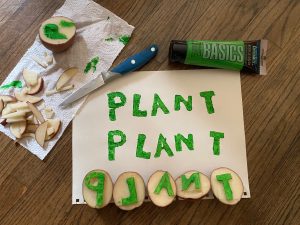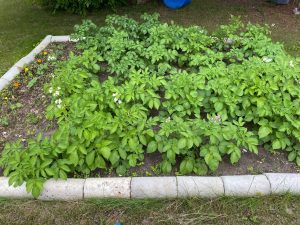
Potato printing and the supplies I used to create the print.
I chose to print the word PLANT in green acrylic paint on textured drawing paper. Initially, I wasn’t sure if I should capitalize the word as though it was at the beginning of a sentence or print it in upper- or lowercase letters. I settled on uppercase letters because straight lines are much easier to cut into the potato. After imagining how the letters should look, I realized that they needed to be cut facing backwards, which took more concentration than I thought it would. Because of this, I feel that the letters are less neat and tidy than they would be if I had been able to draw them facing forward.
The total time spent creating my stamps was about fifteen or twenty minutes. If I were to do the activity again, I would spend some more time on this step. Only after applying the paint and stamping the letters on the page did I notice that the cut surface of the potato was uneven. This led to the letters looking patchy because the paint was in crevices of the potato tissue and did not touch the paper initially. I attempted to remedy this by adding some more paint and pressing the potato down more firmly to the paper, which resulted in excess paint around the edges of the letters.
Having completed this exercise, I am very grateful for the mechanization of writing. It gave me some perspective on the immense amount of work it must have taken many people over many years to write and reproduce texts. When trying to reproduce the word for a second time, I became aware of how challenging it was to maintain spacing between the letters. The creation of technologies such as the printing press and typewriter eliminated this problem and allowed for pages of tiny, uniformly-spaced words that allowed for easier reading.

I’ve included a photograph of my potato garden from this summer. I liked the connection between using potatoes to print the word PLANT and showing an image of my plants that will grow new potatoes.
Hi Jacey, I sympathize with your challenges in potato printing. I too found that I couldn’t get it quite right with the amount of paint. To begin, I started of carving the letters wrong, and then was thwarted again with he style of letters and some letters were hard to apply even pressure too. It has made me appreciate the advancement of text technologies. My daughter recently was asking about calligraphy and I had flashbacks when we would visit a heritage school where we got to experience writing with an ink bottle. It was a disaster. Most schools have moved away from teaching cursive. Do we have a need to write in cursive anymore? Even signatures can be digital and there is nothing to say that it has to all be joined letters.
Bolter (2001, pg.3) believes that electronic technology provides a range of new possibilities, whereas the possibilities of print seem to have been played out. do you think that is the case? I know that I find typing so much faster to get information down, so if its purely for speed, then yes I would imagine that the physical writing on a page may gradually fade away. Even simple notes we would write to ourselves can me dictated into our phone to remind us of all the day to day tasks to accomplish. Reading text though can be equally enjoyable in print and on a device. I cannot say for myself that I would choose one or the other, but the advantages when reading for note taking verses reading for enmojoment then technology wins every time.
I am not a gardener so I appreciate your pictorial connections to the colour and word choice in the task.
References
Bolter, Jay David. (2001). Writing space: Computers, hypertext, and the remediation of print [2nd edition]. Mahwah, NJ: Lawrence Erlbaum.